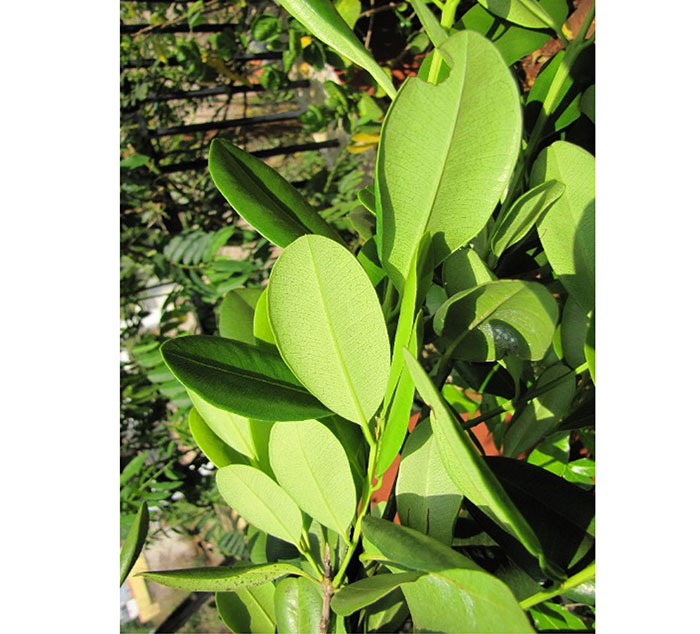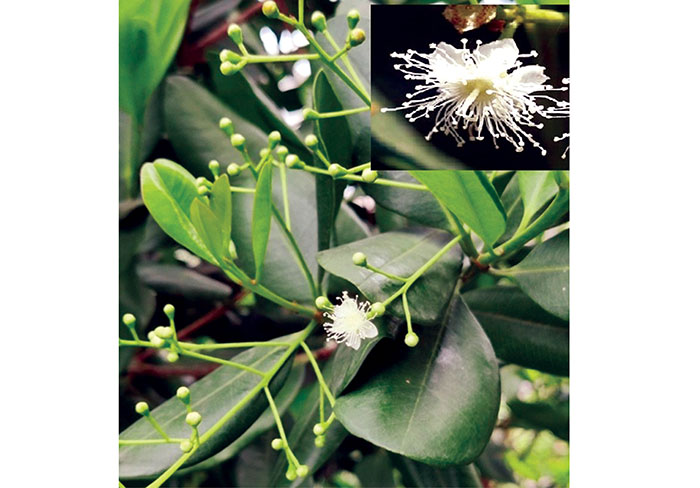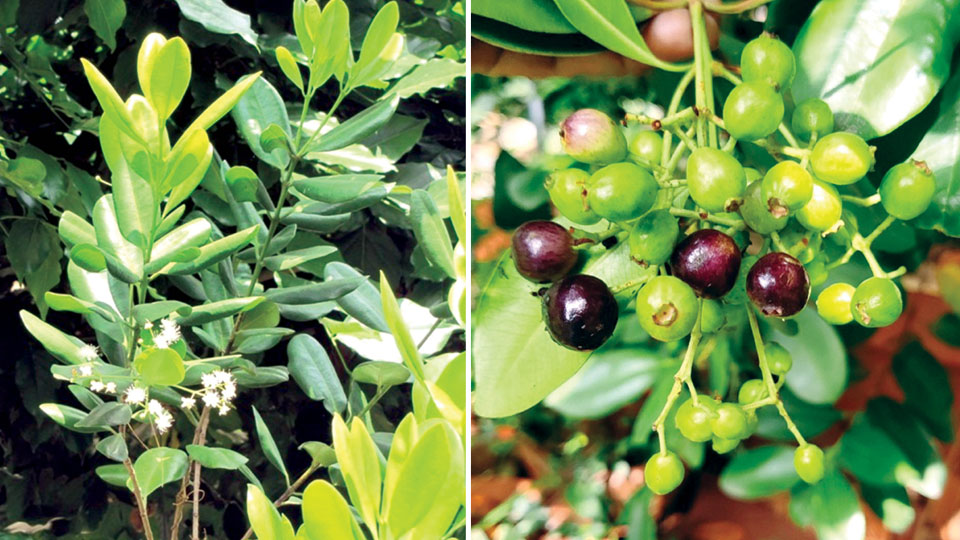Text & photographs by Dr. Mahadeswara Swamy
Many plants possess distinctive aroma, flavour or fragrance. The whole plant or some parts may be aromatic like root, wood, bark, foliage, flowers, fruits, seeds. They are called aromatic plants. Aromatic compounds are basically essential oils made up of low molecular weight terpenoid compounds (phenylpropenes and terpenes) which evaporate at room temperature (volatile). They possess biological activities and widely used as spices in culinary preparations for flavouring and fragrance, herbal beverages, cosmetics, aromatherapy, pesticide repellents etc. A few examples which we come across in our daily life are Mint (whole plant), Turmeric (root), Ginger (stem), Coriander, Curry leaves (leaves), Cloves (flower buds), Sandal wood (wood); Cardamom, Pepper (fruit), Cinnamon (bark). ‘Allspice’ is one such aromatic tree yielding spice(s) derived from the dried, unripe fruits & leaves. It is so named because it combines the flavours of cloves, black pepper, nutmeg and cinnamon, though, in my opinion, it has an unique flavour of its own.
Other names are Myrtle Pepper, Jamaica Pepper, Pimenta, Pimento, English Pepper or New Spice berries. It is a Jamaican tree extensively cultivated therein. It was discovered by early Spanish explorers. They called it ‘Pimentia’ (pepper in Spanish) because of its similarity to black pepper corns. However, name ‘Allspice’ was coined later by English in 1621. It was much more popular in the early 20th century than it is today. Its introduction to India is recent and cultivated in certain isolated pockets of Kerala, Karnataka, West Bengal, Bihar and Odisha. Botanical name is Pimenta dioica (synonym: Myrtus dioica L.) belonging to the family Myrtaceae (Jamun family). The generic name is derived from the Spanish word pimienta, meaning “peppercorn” referring to the berries and the specific epithet ‘dioica’ alluding to dioceous nature of the tree (male and female flowers on separate plants).
Description: It is an aromatic, evergreen tall shrub or a small tree profusely-branched with dense foliage and rounded canopy, normally attaining a height of 20 to 30ft. Almost similar to bay laurel in size and form. Under favourable conditions it can attain a height of 50 ft with the bole up to 30 cm in diameter. Bark gray and young branches are glandular and pubescent. Leaves opposite in position, oval-oblong to elliptical, leathery, deep green on upper surface and lustrous, glandular on under surface, 5 to 8 inches long and 2 inches wide. Inflorescence is a racemose cyme (panicle). Flowers: Small, creamy white to greenish-white, consist of 4 tiny petals, 1 ovary, 2 ovules & 1 style, and a cluster of anthers. Fruit: A berry, sub-globose, small like pepper, hard with rough surface, densely covered with glands; contains two kidney-shaped dark brown seeds; young berries green, ripe into reddish-brown later. Tree blooms from the upper leaf axils in summer. The style straightens when the flower opens, the stigma is raised above the anthers.
Gender status: Very peculiar. Individual flowers are structurally hermaphrodite (possess both male and female parts present within the same flower) but Individual trees are functionally dioecious (plants are either male or female)! The floriferous trees which fail to produce viable berries (barren trees) are designated as “male” trees, while the berry bearing trees as “female”. It seems some form of incipient dioecy is operative in the plant species.

Culinary and medicinal uses
Culinary use: The aromatic & pungent berry with a distinct aroma is a wonder spice, used all over the world for culinary purpose. The berries are harvested (hand picked) before they are fully ripe and dried in the sun. They turn from green to dull reddish brown on drying. Later they are stored either whole or in powdered form for use. Whole dried fruits are supposed to have a longer shelf life than powders. It can be ground or crushed when needed.
In its nativity (Jamaica), allspice berries under the name ‘Jamaican pepper’ is an important ingredient for making ‘Jamaican jerk seasoning’, a cooking process in which meat is dry-rubbed or wet marinated with a hot spice mixture called Jamaican jerk spice containing pimento. In West Indies, a popular drink called “Pimento dram” or ‘Allspice dram’, a rum-based herbal liquor flavoured with the distinct taste of allspice is prepared. Allspice was introduced to European and Mediterranean cuisines in the 16th century. It is indispensable for cooking in Middle Eastern Levant region (Eastern Mediterranean shores, covering Israel, Jordan, Lebanon, Syria etc.), where it is used to flavour a variety of stews and meat dishes and tomato sauce. In northern European and North American cooking, it is used in sausages, curry powders and pickling. It is used in desserts for giving Cincinnati-style chilli with a distinct aroma and flavour in the US. Cakes & a variety of dishes are made in addition to beauty products using pimento in Great Britain. In the Azores islands of Portugal, it is used in the preparation of traditional stews cooked in large terracotta pots. Known under the name English herb (Polish: ziele angielskie), allspice is also used in Polish cuisine (dishes, soups and stews). Arab & Mexican cuisine are no exception in using this spice.
Leaves are also used in cooking in somewhat the same manner as bay leaves.
In India, its use is recent and leaves are being used as a replacement or as an alternative to bay leaves.
Essential oils: Essential oils are extracted from leaves and bark. Volatile oils content varies from 2.5-4.5% depending on origin, parts used, weather, harvesting and processing conditions. Main constituent is eugenol (60-75%). Other components are eugenol methyl ether, cineole, phellandrene and caryophyllene. Interestingly oil extracted from leaves has a different flavour. Oil is used in medicines and perfumes.
Medicinal uses: Allspice is carminative and an aromatic stimulant. Used in the form of Pimento water, pimento oil or powdered form, it is useful against indigestion and flatulence. The oil acts as a compliment for less appetising medicines and supposed to reduce chances of crampness. It is also a good antioxidant. Allspice when used as a plaster acts as a revitaliser for rheumatism and neuralgia. The eugenol in allspice oil has bacteriocidal, fungicidal and nematicidal properties and used as an antiseptic.
Other uses: Leaves & bark contain tannins and can be used for tanning hides & skins. Firm and hard salmon colour wood with smooth surface & close texture, is useful for making walking sticks and umbrella handles. Furthermore, wood is traditionally used to smoke jerk in Jamaica.

Useful tips
With dense leaves it makes a beautiful ornamental foliage tree. It is ideal for home gardens and narrow avenues. I have grown one in my small garden.
It can be grown in container pots too: Makes a beautiful houseplant.
It can be grown as a border tree on bunds in farms.
It is also useful to provide shade for coffee trees in mixed farming.
Very easy to grow, it can be grown with normal garden soil and watering.
Care must be taken while drying berries/ leaves to ensure that volatile oil, such as eugenol, remains in the end products.
Needs plant protection measures in case of pest attack by tea mosquito bugs or diseases like leaf spot or leaf rot.
There is lot of scope to cultivate this multipurpose tree as a plantation crop on large scale for useful application in medicine and condiments.
Propagation
Allspice is propagated by seeds. Fully ripe berries of high yielding trees are soaked overnight in water. Next day the seeds are separated & removed by rubbing the softened berries and sown in nursery beds or pots. They germinate in two weeks time. Adding leaf mold/ dried powdered leaves (mulching) enhances germination. Six to ten months old saplings are ideal for planting in the field with a spacing of 12 to 15 ft. Shade and regular irrigation should be provided to young plants. Manuring, weeding and mulching is recommended at regular intervals. It can also be propagated vegetatively by grafting and tissue culture methods.
Where to see
In some farms and private gardens. A decade back I came across this tree in a private farm near Chamundi Hill.
Scientist Mob: 97429-91057
e-mail: [email protected]








Recent Comments